Journey into the mesmerizing world of bees and discover the evolutionary secret behind their ability to see ultraviolet light.
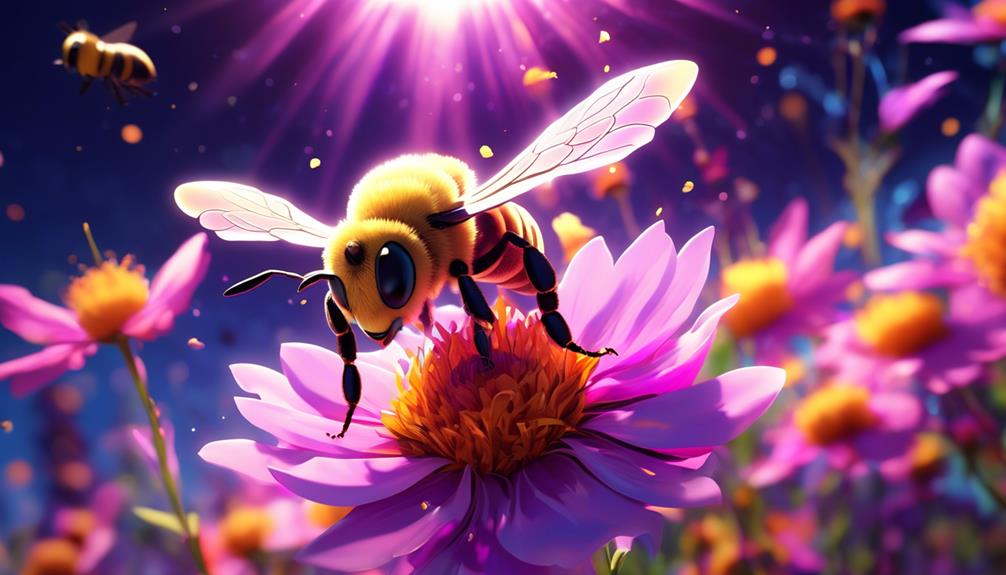
Why Can Bees See Ultraviolet Light?
'Unlocking the secret behind bee vision is like piecing together a complex jigsaw puzzle.
You've probably wondered why bees, unlike humans, have the ability to see ultraviolet light. It's not just a random quirk of nature, but an evolutionary advantage that plays a crucial role in their survival and the functioning of our ecosystem.
How does this work exactly? Well, that's a fascinating story you're about to uncover.'
Key Takeaways
- Bees have trichromatic vision sensitive to ultraviolet, blue, and green light, allowing them to perceive patterns and colors that humans can't.
- Ultraviolet light is invisible to human eyes but bees can detect it, with their most sensitivity being to UVA light.
- Bees' ability to see UV light has evolved over millions of years and provides them with a significant advantage in locating and distinguishing between flowers.
- Bees' UV vision influences their foraging habits, navigation, and pollination efforts, playing a pivotal role in maintaining plant biodiversity and supporting the ecosystem.
Understanding Bee Vision
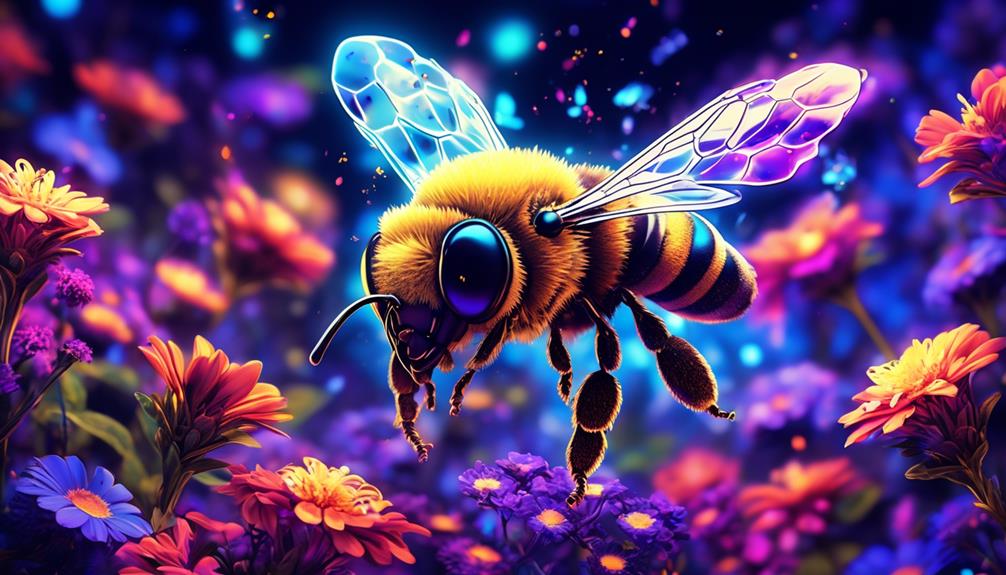
To fully grasp how bees perceive their environment, it's crucial to delve into the intricacies of their unique visual capabilities, which notably include the ability to see ultraviolet light. Unlike humans, bees have trichromatic vision which is sensitive to ultraviolet, blue and green light. This means they can perceive patterns and colors we can't, enabling them to detect certain floral guides and nectar.
While we see only a flower's surface, bees detect the UV patterns on the petals that lead them to the nectar. Their compound eyes, composed of thousands of tiny lenses, allow them to perceive polarized light – a feature used to navigate using the sun.
Moreover, their ocelli, three simple eyes on top of their head, are sensitive to light intensity. They don't form images but provide information about the sun's position and light intensity, which is vital for orientation and timing of their activities.
The Science Behind Ultraviolet Light
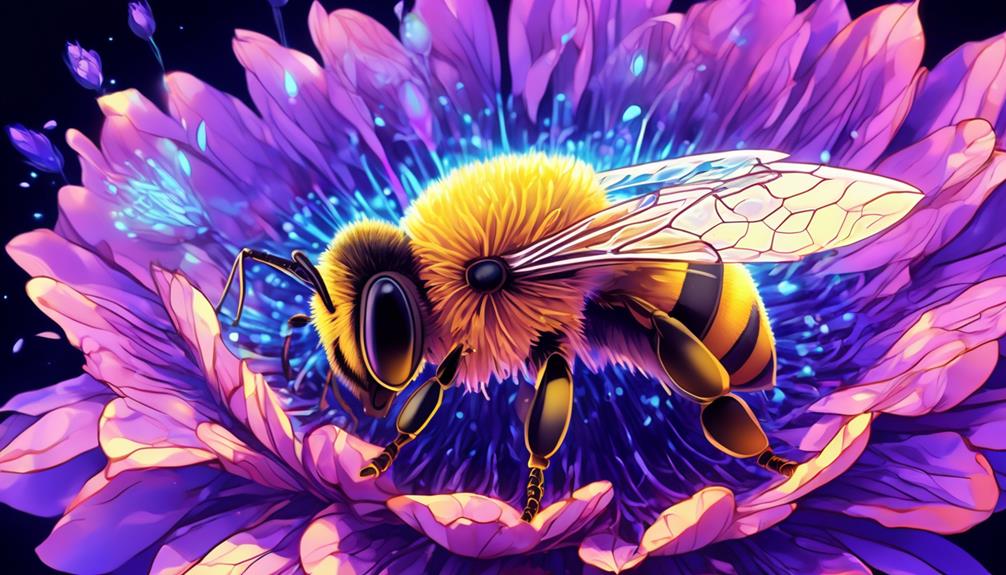
Understanding the science behind ultraviolet light, you'll discover it's a type of electromagnetic radiation that bees' eyes are uniquely equipped to detect. You may already know that light is a spectrum, and UV light, invisible to human eyes, is just beyond the violet end. But for bees, UV light is as perceivable as red, green, or blue light is for humans.
UV light is characterized by its short wavelengths, between 10 and 400 nanometers. It's further categorized into three types: UVA, UVB, and UVC, based on the varying range of wavelengths. Bees are most sensitive to UVA light, which ranges from 315 to 400 nanometers. This sensitivity allows them to detect patterns on flowers that are invisible to the human eye, guiding them to nectar.
Your understanding of the science behind UV light isn't just for appreciating bees. It's also crucial for grasping how UV radiation impacts our environment and health. For instance, UVB light, though necessary for vitamin D synthesis in humans, can cause skin damage and cancer with prolonged exposure. So, while UV light is a boon for bees, it's a double-edged sword for humans.
Evolution of Bees' UV Vision
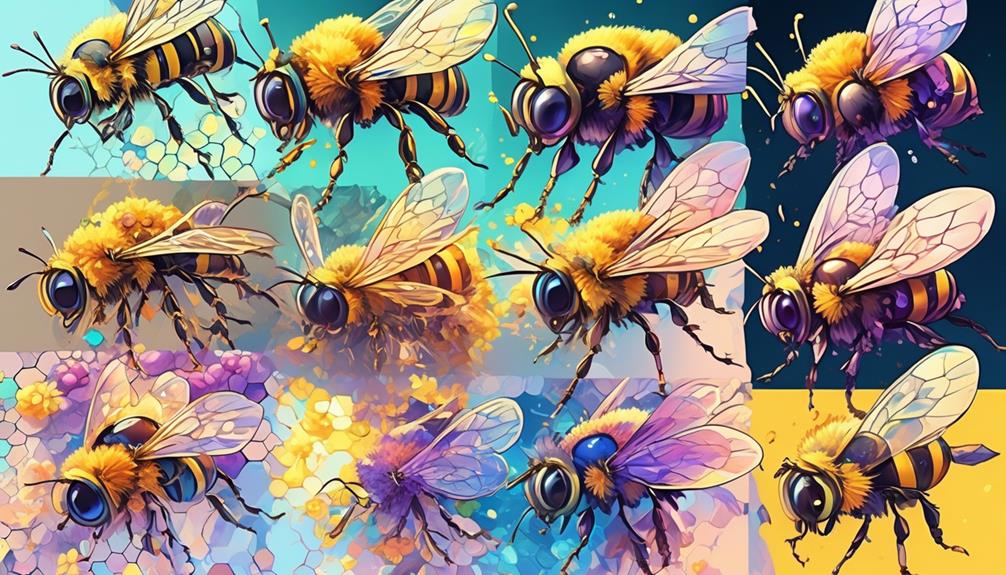
While you may marvel at bees' ability to perceive UV light, it's the result of a fascinating evolutionary process that has enhanced their survival and pollination efficiency. Over millions of years, bees' vision evolved to include the ability to see UV light, a spectrum invisible to most other species, including humans.
This evolution wasn't random, but rather a product of natural selection, where advantageous traits are passed down through generations. In the case of bees, seeing UV light gives them a significant edge. It allows them to locate and distinguish between different types of flowers with greater precision, as these plants often reflect UV light in unique patterns.
This trait also plays a vital role in their communication. As you may know, bees perform a 'waggle dance' to convey the location of food sources. Interestingly, the dance's effectiveness is boosted by UV light, which bees use to orient themselves.
UV Vision's Impact on Bee Behavior
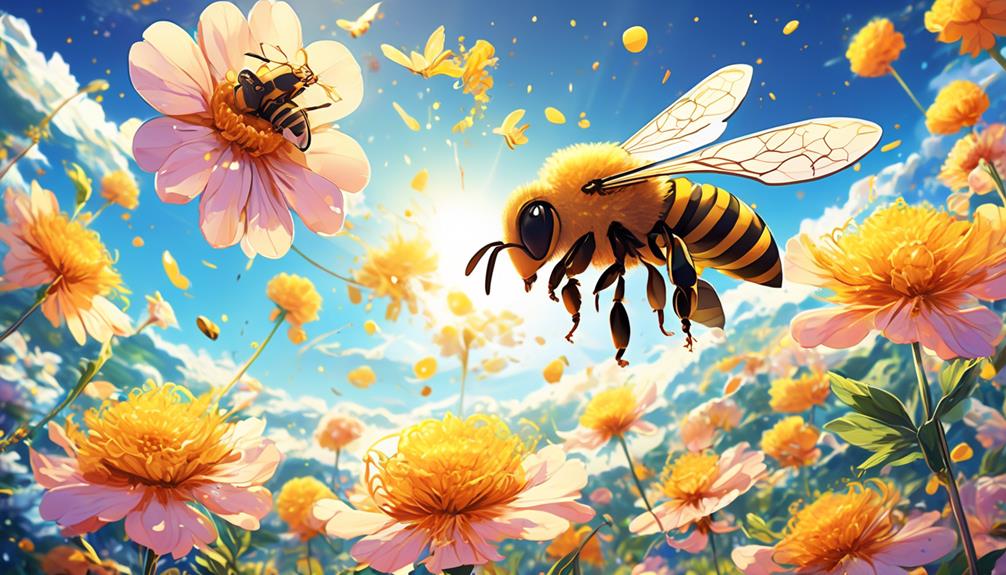
Having explored the evolutionary aspect of bees' unique UV vision, let's now examine how this remarkable ability shapes their behavior in day-to-day life.
You might be surprised to learn that bees' UV vision has a profound influence on their foraging habits. UV vision allows bees to detect patterns on flowers that are invisible to the human eye. These patterns, called nectar guides, direct bees to the flower's nectar source. This speeds up the foraging process, increasing efficiency and, consequently, the bee's survival rate.
Moreover, bees use their UV vision to navigate. By observing polarized light patterns in the sky, which are only visible in the UV spectrum, bees can determine the sun's position even on cloudy days. This innate celestial navigation system enables them to find their way back to the hive after foraging.
Role in Pollination and Ecosystem

Bees' unique ability to see ultraviolet light doesn't just aid in their survival, but also plays a pivotal role in pollination and maintaining the balance of our ecosystem. Through UV vision, bees can identify the nectar guide patterns on flowers, which are invisible to the human eye. These patterns guide bees towards the nectar and pollen, thereby facilitating pollination.
You might wonder, "What's so important about pollination?" Well, it's crucial for the reproduction of flowering plants, including many of our food crops. Without bees, plant biodiversity would suffer and our food system would be under significant threat.
To help you appreciate the role of bees, consider the table below:
Impact of Bees | Consequence Without Bees |
|---|---|
Pollination of food crops | Severe food shortage |
Maintenance of plant biodiversity | Loss of various plant species |
Production of honey and beeswax | Loss of these natural products |
Support for wildlife food chain | Disturbance in the ecosystem balance |
Enrichment of soil through fallen leaves | Poor soil fertility |
Human Applications of Bee UV Vision

Understanding the importance of bees' UV vision in ecological systems, let's now explore how this unique ability has found applications in human technology and innovation.
It's intriguing how we've harnessed this insect's capacity to perceive ultraviolet light to advance our technological prowess.
One area where bee UV vision has been applied is in the development of cameras and imaging systems. Companies are now designing cameras that can detect ultraviolet light, mimicking the bees' unique vision. These cameras are particularly useful in forensic science for detecting evidence not visible to the naked eye. Additionally, in the field of astronomy, UV cameras help in the detailed study of celestial bodies.
Furthermore, bee UV vision has inspired the design of solar panels. By studying how bees use UV light to find nectar, scientists have improved the efficiency of solar panels. This biomimetic approach helps solar panels absorb more sunlight, thereby increasing their energy output.
In agriculture, knowledge of bee UV vision aids in the creation of more effective pollination strategies. By understanding which colors attract bees the most, farmers can plant crops in a way that maximizes pollination, thus boosting yields.
Thus, the unique UV vision of bees has found diverse and significant applications in human life and technology.
Frequently Asked Questions
What Other Insects, Besides Bees, Can See Ultraviolet Light?
You're curious about other insects that can see ultraviolet light.
It's not just bees! Many insects, including butterflies, dragonflies, and certain beetles, also possess this ability. They've developed specialized photoreceptor cells that allow them to detect these wavelengths.
This helps them locate food, mates, and navigate their environment more effectively.
How Does UV Vision Affect the Lifespan of a Bee?
You might think UV vision shortens a bee's lifespan due to harmful radiation. However, it's not the case. Bees have evolved to use UV light to find flowers, nectar, and pollen more efficiently.
It doesn't hurt them but enhances their survival. They're not exposed long enough to suffer radiation damage. So, UV vision doesn't affect a bee's lifespan negatively, but rather, it's a positive adaptation for their survival and success.
Are There Any Negative Effects on Bees From Being Exposed to Ultraviolet Light?
You might think UV exposure harms bees, but it's not that simple.
Bees' UV vision is a natural adaptation that doesn't seem to negatively affect them. They've evolved to use UV light for navigation and finding nectar. So, contrary to what you might expect, exposure to UV light isn't detrimental to bees. It's part of their everyday life and essential for their survival.
However, excessive UV radiation, like in any creature, could potentially cause harm.
How Does a Bee's UV Vision Compare to Other Animals With the Same Capability?
When comparing a bee's UV vision to other animals, it's quite remarkable. They're not unique in having this ability, but their UV vision is particularly fine-tuned.
Many birds and reptiles also see UV light, but bees specifically use it to locate flowers and nectar. They can detect patterns on petals that are invisible to the human eye, giving them an edge in their search for food.
Can the UV Vision of Bees Be Used to Develop New Technology for Humans?
Absolutely, you can harness the UV vision of bees to create innovative technology for humans. This could lead to the development of UV cameras or imaging tools, improving our ability to detect counterfeit money or diagnose skin conditions.
It's a fascinating field of study, with the potential to revolutionize how we see and interact with the world around us. You're just scratching the surface of the possibilities.
Conclusion
So, you see, bees' ability to perceive ultraviolet light isn't just a cool trick; it's an evolutionary advantage that drives their behavior and supports our ecosystems.
This unique vision aids in their crucial pollination role and has potential human applications such as UV detection technology.
Understanding and appreciating this aspect of bee biology not only deepens our knowledge of nature, but also highlights the interconnectedness of life on Earth.



